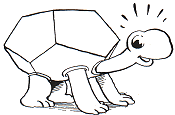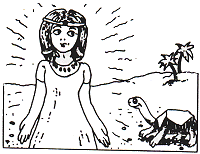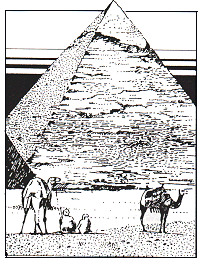
|
Feedback Form


THE CONTINUING ADVENTURES OF MYRTLE THE TURTLE AND THE TIME MACHINE

Geometry Microworld Part II by Chris Gregory Senior Lecturer in Mathematics at Bradford and Ilkley Community College.
Geometry Microworld Part I was published by Valiant Technology in May 1986. Against a background story of Myrtle the Turtle travelling back in time and helping to invent geometry the Microworld presents a series of interesting Turtle activities. The next few issues of GO will publish Geometry Microworld Part II.
The story so far: Myrtle the Turtle has travelled back in time and has taught Grub the caveman to measure and Ded-Loth the Egyptian to mark out his fields. She had decided to visit the Pyramids but they were not there...

Myrtle was disappointed and was about to retum to the time machine when she heard a strange voice.
"Myrtle, how nice to see you. I've been expecting you. How are you?"
Myrtle turned and saw a beautiful woman. She was standing in the desert surrounded by light. "Who are you?" Myrtle asked.
"I am Sesheta, the Goddess of Construction and Civil Engineering".
"A G-G-G-Goddess, I've never met a G-G-G-Goddess before".
"It's alright Myrtle, we don't bite," Sesheta thought for a moment. "Well some of us do, but I don't. I am here to build the pyramids and I need your help".
"I wish I could help but all I can do is draw" Myrtle said.
"Drawing is a very important job, Myrtle. Can you draw squares and triangles?"
Myrtle nodded.
"Then you can help build the Pyramids by drawing the designs in the sand."
Myrtle quivered with excitement. Sesheta explained how to mark out a square and the triangular sides of the Pyramid and Myrtle worked hard for the rest of the day. That evening Sesheta said goodbye. Myrtle trundled across the sand towards the flashing lights of the time machine.
POLYGONS AND POLYHEDRA
The activities focus on regular polygons - shapes in which all sides and
angles are equal, and polyhedra - three dimensional shapes, the faces
of which are polygons. These activities are suitable for introducing procedures,
using variables as inputs and the 'top down' approach to programming (breaking
a large task into several smaller, more manageable tasks).
Draw the plans for the Pyramid
It will be useful if you can make a model of a pyramid.
Program the Turtle to draw an equilateral triangle and a square to represent the construction plan. Before writing the program, the children should examine the model. They should discuss the shapes needed and their relative sizes.
Some children may be ready to write the program using procedures. Others will prefer to use direct commands. If this is the case, encourage them to record the commands. It will help gain an overall understanding of what they are telling the Turtle to do.
Children who are ready to write their instructions in programs will be able to save them on disk. Where appropriate the Logo procedural approach to geometry can be used. This method creates shapes by description rather than algebraic formula or obscure drawing techniques. For example, SQUARE indicates that a square has four equal sides and four angles of 90 degrees.
These activities may be attempted by young children who have little or no formal understanding of measuring in degrees. Seymour Papert cites examples of children who regarded angular inputs as codes which determined how much the Turtle turned.
| Program for Triangle | Program for square |
| TO TRI PENDOWN FD 30 RT 120 FD 30 RT 120 FD 30 RT 120 PENUP END | TO SQUARE PENDOWN FD 30 RT 90 FD 30 RT 90 FD 30 RT 90 FD 30 RT 90 PENUP END |
| Or using the REPEAT facility: | |
| TO TRI PENDOWN REPEAT 3[FD 30 RT 120] PENUP END | TO SQUARE PENDOWN REPEAT 4[FD 30 RT 90] PENUP END |
 Draw Different
Sized Triangles and Squares
Draw Different
Sized Triangles and Squares
When children can draw a triangle and square, ask them to draw the shapes
with different sizes. Again, some children will use the direct drive method.
Other children may alter the value of the FORWARD command inside a procedure.
A more elegant and versatile method is to use a procedure with a variable
input.
It is interesting to note if the children appreciate which value must remain unchanged (angle) and which must alter (sides).
The variable is a powerful and fundamental mathematical concept and should be introduced with caution. Logo programs and the Turtle offer a medium through which children may become familiar with the idea.
| TO TRI: SIDE REPEAT 3 [FD: SIDE RT 120] |
| TO SQUARE: SIDE REPEAT 4 [FD: SIDE RT 90] |
| Different sized polygons can now be drawn with specific input: TRI 30, TRI 50, SQUARE 30, SQUARE 50 etc. |
| SQUARE AND TRIANGLE PROGRAMS USING VARIABLES |
FURTHER ACTIVITIES
Exploration of some aspects of the history of practical geometry can be
interesting in itself, and can offer an appreciation of why such ideas
as ratio, and the properties of triangle received so much attention. Setected
material, including some of the actual techniques used in e.g. surveying
or navigation can add another dimension to the work.
| Back |
|---|